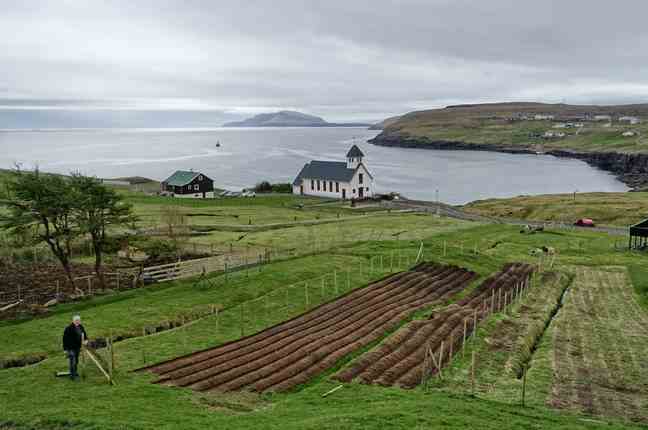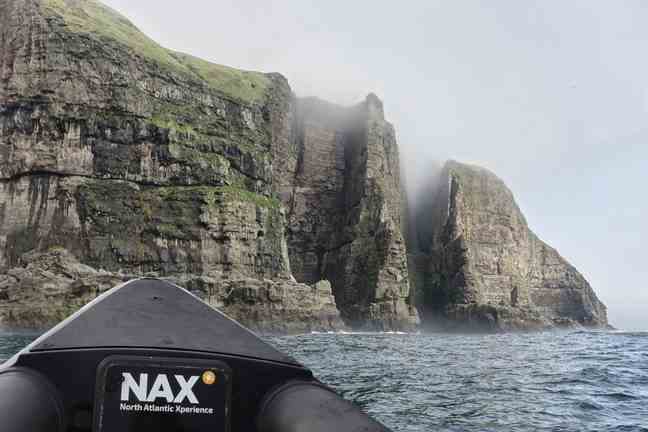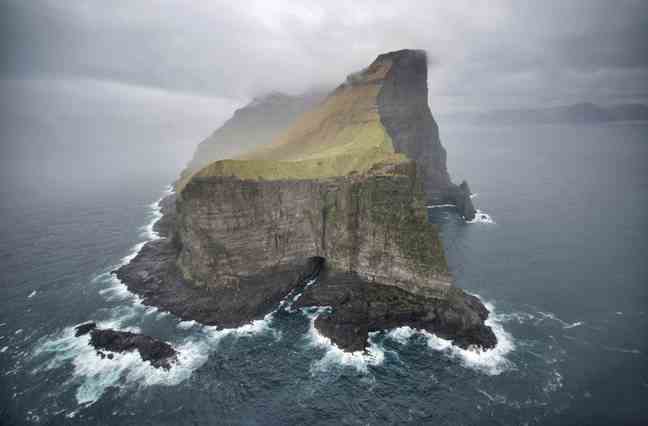Once upon a time there was a land lost in the clouds, where a raw nature imposed respect on a close-knit population… Thus begins the fairy tale that leads well-inspired travelers to the Faroe Islands. Secluded on the borders of the North Atlantic, in the center of a triangle formed by Scotland, Norway and Iceland, this subarctic archipelago is one of the last wild territories in Europe.
Although a constituent country of the Kingdom of Denmark, this chain of eighteen small islands has full autonomy and does not belong to the European Union. The Faroese mint their own coins, brew excellent beer, fish in their exclusive waters and obey the laws of a Parliament founded in the 10th century. This geographic and political isolation results in a near-ideal micro-society, with the lowest unemployment and crime rates in the world.

The 53,000 Faroese are proud to recall their Viking ancestry. A third of them are concentrated in Tórshavn, “the port of Thor”. Their language is also closer to Icelandic than Danish. In Old Norse, faer means sheep and oyar refers to the islands. The Faroes, or Føroyar more exactly, therefore translates as “sheep islands”. Nothing surprising as the ovidae thrive there. They would be some 90,000 to circulate freely, from the green slopes to the roundabouts.

The cultural integrity of the Faroes was one of the criteria used by experts from National Geographic magazine when they ranked the destination as one of the “most fascinating islands in the world”. The Faroese, whose standard of living only increased late in the 20th century, fiercely maintain traditions that were once vital in the face of shortages. Some are sometimes decried, such as the grindseasonal pilot whale fishing, the meat of which is distributed free of charge to the community.
In a country without trees, where growing simple potatoes is a feat, the sea has always provided enough to survive. And the fear of missing out remains rooted in the collective unconscious. Each house has a hjallur with perforated walls where meat and fish ferment under the spray.

Another indisputable asset also allows the country to distinguish itself: the virginity of its nature. Indeed, even if the Faroe Islands extend a warm welcome to their visitors, and although direct weekly flights now connect them to major capitals like Paris, their solitary archipelago is still very far off the beaten track.
This harsh land, constantly fought over by rain and mist, is one of the wettest on the planet! Eydun Berg, who runs the tailor-made excursion company North Atlantic Xperience, advises to “always have a plan B, and even a plan C, before setting off on an adventure”. But here more than anywhere else, nature rewards those who take the plunge.

Breathtaking
Nearly eight hundred fjords carve the geography of the Faroes. The sea is omnipresent there. Wherever you walk in the archipelago, you are never more than five kilometers from the waves. And on these pebbles with their sides jagged by erosion, you are never very far from an extraordinary landscape either. The Faroes have the highest walls in Europe, some of which rise to over 700 meters in the Vestmanna Fjord.

On the island of Vágar, a perimeter of ten kilometers around the airport alone unites some of the most beautiful fantasies of nature. On the east side, Lake Sørvágsvatn, which cascades into the ocean, offers a surreal view from the top of the surrounding cliffs. On the west side, a river runs under the hamlet of Gásadalur before dropping into the waves.
Needless to insist on the beauty of the place when the sun manages to pierce the clouds! However, no sign indicates these prodigious sites. You have to ask the locals to find them. There lies all the magic of the Faroes: after a hesitant journey that often ends across the field, the visitor finds himself alone, face-to-face with the elements…

On the sodden meadows that cover the basaltic reliefs, the only touches of color are provided by the facades of the houses and the beaks of the puffins. At the western end of the archipelago, these seabirds rule the island of Mykines.
Recognizable by their sad clown gaze and their large colorful beak, they are the most endearing representatives of the local fauna. Their colony coexists here with cormorants and gannets. Unafraid, all these birds allow themselves to be approached, to the delight of photographers and ornithologists whose love at first sight with the Faroes is guaranteed in advance.

Moviegoers, meanwhile, are eyeing the other side of the archipelago, towards the island of Kalsoy. It’s because James Bond has recently been there! The spectacular point of Kallur has, in fact, served as the setting for the last scenes of Dying can wait, the 25th part of the saga. When the film was released, the Faroese spectators all waited until the end of the credits to applaud their compatriot Jóhannus Kallsgard, credited as the “King of Kalsoy”. This is how this young farmer was thanked for welcoming the film crew on the Kallur cliffs.
A stele in honor of agent 007 has been installed on the dizzying heights of his property. The image of its inauguration by Jóhannus and the Prime Minister of the country went around the world in early 2022. Since then, the site has regained its tranquility. It remains wonderfully welcoming and preserved, like all the Faroes.
Go
Although wetter than May, July offers very long days for the national holiday of St. Olav and the many festivities that accompany it.
Until this year, you had to transit through Copenhagen to reach the Faroe Islands. But the archipelago is now accessible in 2h40 from France. Atlantic Airways has just opened a direct link between Paris-CDG and Vágar airport. Until October 17, 2022, the Faroese airline operates two weekly flights, Mondays and Thursdays, from 407 euros A / R.
Atlantic Airways also hashelicopters to move from island to island. Tórshavn Heliport is within walking distance from the city center. This fast and spectacular mode of transport is surprisingly affordable in the Faroes. Between 15 and 50 euros per trip. But the fog makes the rotations random. The lack of visibility, on the other hand, poses no problem for the company’s Airbus 320neo, which are equipped with an ultra-precise navigation system allowing them to land blind.
Move
The car is the ideal mode of transport to explore the main islands, connected by impressive underwater tunnels. No need for GPS. There are so few roads that a road map is enough to find your way around. However, some data should be taken into consideration. The traffic lanes, always well maintained, are sometimes very narrow and steep. Sheep can appear at any time. And the vagaries of the weather can complicate everything.
Housing
Wherever you choose to stay on the archipelago, most of the islands remain accessible during the day. With its 19,000 inhabitants, the capital of the Faroes is a city on a human scale where you immediately feel at ease. On the heights of Tórshavn, the hotel Hilton Garden Inn is one of the largest and finest establishments in the country. With its large rooms with practical equipment, this new address is a comfortable base camp for touring the country.
Restore
Vegetarians will find it difficult to appreciate the culinary habits of the Faroese. Mutton and fish are indeed de rigueur at all meals in a country where almost no vegetables grow. Located in a small cozy building on the port of Tórshavn, Rocks is a casual new take on the star-studded restaurant Koks. Locals flock there to discover the flavors of the sea revisited with creativity. For a more intimate experience, farmers also open their doors to visitors. This is the case ofAnna and Oli Rubeksen who offer to taste traditional preparations (sometimes disconcerting, such as cod with fermented sheep’s stomach) in front of a dream panorama.
Have
Kirkjubøur is the most important historical site of the archipelago, with its Lutheran church, the ruins of Saint Magnus Cathedral and the Roykstovan farmhouse, one of the oldest inhabited wooden constructions in the world. Seventeen generations of the same family have lived in this house filled with memories. An exciting visit, when commented on by Jóannes Patursson, the current owner.
To listen
Music is very present in Faroese society. Attached to their culture, national artists such as Eivør, Orka or Budam Man, bring traditional sounds up to date with folk, rock or jazz rhythms. They are all produced by the only record company in the archipelago, Tutl Records, which also has an eco-museum and a sales point in Tórshavn. Music lovers can meet Kristian Blak, the label’s creative musician, there.
Information
In addition to the essential advice for preparing your trip, the site of theFaroe Islands Tourist Board book of fascinating information on local customs and legends.

